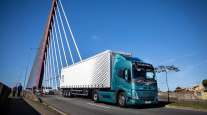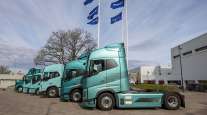Volvo Trucks’ Nyberg Sees Opportunities in Additional Markets, Alternative Fuels

This story appears in the Dec. 24 & 31 print edition of Transport Topics.
Göran Nyberg, Volvo Trucks’ new president of North American sales and marketing, pointed to opportunities in the regional and vocational markets, alternative fuel offerings and an expanding dealer network as keys to the company’s growth.
During a Dec. 18 editorial forum with Transport Topics staff in Arlington, Va., Nyberg said he sees room for Volvo to grow beyond its core strength with longhaul truckers.
“My first impression is that we have done an excellent job when it comes to the long-haulage part of the business. There is more to do in the regional haulage, day-cab, vocational business, and I believe that we can take a slice of a few others’ segments in the industry to improve our share of business,” he said.
He also touted the strength of the company’ powertrain products, noting that 80% of Volvo trucks sold come with Volvo power, and 50% of those feature the company’s I-shift automated manual transmission.
Nyberg, who started his current role Oct. 1, succeeded Ron Huibers, who was appointed president of Volvo Penta Americas. Nyberg previously was managing director for Volvo Group UK Ltd., the Volvo Trucks sales and marketing division in the United Kingdom.
Earlier in December, Volvo Trucks announced that its models received certification for meeting 2014 federal greenhouse-gas regulations from the U.S. Environmental Protection Agency and National Highway Traffic Safety Administration (12-17, p. 5).
Volvo Trucks spokesman Brandon Borgna said the company is also “on pace” to achieve 2014 certification for its proprietary engines in advance of the regulation deadline.
Although Volvo’s 13-liter engine is covering “very broad demand” in the market, Nyberg said he believes there is “further room for smaller engines with higher torque,” such as Volvo’s 11-liter engine.
In addition to its diesel engines, Nyberg said, Volvo remains on track to launch its own 13-liter liquefied natural gas engine in 2014. The engine will use Westport Innovations Inc.’s high-pressure, direct-injection technology, which uses a small amount of diesel to ignite the gas.
Volvo also plans to offer Cummins Westport’s ISX12 G spark-ignited natural-gas engine in its trucks when that engine debuts in 2013. “We have orders coming in,” Nyberg said, but he later added that “it’s very limited numbers today.”
Volvo currently offers Cummins Westport’s ISL G 9-liter spark-ignition natural-gas engine in its VNM model day cab.
Apart from natural gas, Volvo continues to explore the prospect of dimethyl ether as a heavy-duty truck fuel in North America.
Nyberg described DME, which could be refined from natural gas, as “the preferred alternative route that we see” from a technology and efficiency point of view, but availability and fueling infrastructure are still question marks.
“It’s a lot of boxes to tick before we can see where this is taking us, and we want to have a readiness for all potential alternatives going forward,” he said.
At a press briefing in May in Miami Beach, Volvo Group CEO Olof Persson said DME is easier to handle than natural gas because it doesn’t need to be highly pressurized or cooled (5-28, p. 5).
Nyberg also said he’s pleased to see private dealer franchise holders investing heavily in their businesses. Volvo’s dealer network has increased its bay capacity in the United States by 20% in the past 24 months, he said.
“We have a strong dealer network and good representation from our dealers,” he said. “They are very active in developing and driving the business.”
Nyberg also discussed the company’s remote diagnostics service, launched earlier this year, which is designed to enable fleets to proactively address equipment problems. Volvo offers the tele-matics service free on its new trucks for two years, after which it becomes subscription-based.
Nyberg said he sees connectivity in the truck as a benefit that remains “a bit untapped.”
“Looking into the future, of course, our ambition is to cover more than just the engine, but it’s a good start, and it’s all about trying to have that proactive approach,” he said. “I think it’s a good step into getting the benefits out of the technology, and we will continue to explore that route.”




